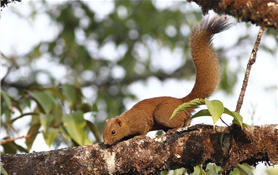关键词:
Biodiversity
biogeography
biotic elements
conservation biogeography
distribution patterns
open areas
reptiles
South American savanna
摘要:
Aim To test predictions of the vicariance model, to define basic biogeographical units for Cerrado squamates, and to discuss previous biogeographical hypotheses. Location Cerrado;South American savannas south of the Amazon, extending across central Brazil, with marginal areas in Bolivia and Paraguay and isolated relictual enclaves in adjacent regions. Methods We compiled species occurrence records via field sampling and revision of museum specimens and taxonomic literature. All species were mapped according to georeferenced locality records, and classified as (1) endemic or non-endemic, (2) typical of plateaus or depressions, and (3) typical of open or forested habitats. We tested predictions of the vicariance model using biotic element analysis, searching for non-random clusters of species ranges. Spatial congruence of biotic elements was compared with putative areas of endemism revealed by sympatric restricted-range species. Effects of topographical and vegetational mosaics on distribution patterns were studied according to species composition in biotic elements and areas of endemism. Results We recorded 267 Cerrado squamates, of which 103 (39%) are endemics, including 20 amphisbaenians (61% endemism), 32 lizards (42%) and 51 snakes (32%). Distribution patterns corroborated predictions of the vicariance model, revealing groups of species with significantly clustered ranges. An analysis of endemic species recovered seven biotic elements, corroborating results including non-endemics. Sympatric restricted-range taxa delimited 10 putative areas of endemism, largely coincident with core areas of biotic elements detected with endemic taxa. Distribution patterns were associated with major topographical and vegetational divisions of the Cerrado. Endemism prevailed in open, elevated plateaus, whereas faunal interchange, mostly associated with forest habitats, was more common in peripheral depressions. Main conclusions Our results indicate that vicariant speciation has stro
 中文科技期刊
中文科技期刊
详细信息
 欢迎来到三峡大学图书馆!
欢迎来到三峡大学图书馆!


